
Xenoblade Chronicles 3 Hands-on Preview: An Exhaustive Analysis of its Opening Hours
Expectations are high for Monolith Soft’s next entry in the Xenoblade series. After the resounding success of Xenoblade Chronicles 2, Xenoblade Chronicles 2: Torna ~ The Golden Country expansion, and the Xenoblade Chronicles: Definitive Edition re-release, Monolith Soft has gradually been building up to the world presented in the series’ next installment, Xenoblade Chronicles 3.
I found the initial trailer announcing Xenoblade Chronicles 3 back in February quite peculiar. Nintendo and Monolith Soft were not shy to immediately share that Xenoblade 3 is a “brand-new story that ties together the futures of the worlds depicted in Xenoblade Chronicles and Xenoblade Chronicles 2.” Frankly, I was initially worried about this framing from the get-go; part of the charm in Xenoblade games to me is that they are largely standalone titles that only loosely reference or connect the other games, yet were isolated enough that newcomers to any of them were not completely left in the dark if they didn’t play prior entries.
With Xenoblade 3, I was concerned that they were shaping this up to be a title that somehow crosses the main casts of Xenoblade 1 and 2 together. It isn’t because I didn’t think it would make for a good game; I just personally prefer fresh storylines that further flesh out the world from a new perspective, rather than revisiting an entire cast of characters that have already concluded their tales together. Much to my delight, Xenoblade 3 presents a brand-new set of main characters to learn about.
I can only speak about the first few hours of Xenoblade 3 for the purpose of this preview. All story beats laid out in this piece only cover up to the end of Chapter 1. If you want to go in completely fresh without any prior knowledge, this is your warning. Most of the game’s premise has been shared with the recent Nintendo Direct that focused on Xenoblade 3, though there will be additional details I’ll mention to provide some context of my initial impressions.
Once again, all significant storyline events in this Xenoblade 3 preview below this point happen in Chapter 1.
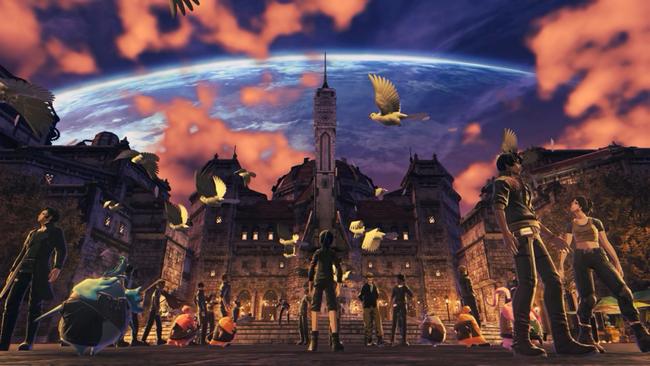
What immediately stuck out to me in the opening hours of Xenoblade 3 is that the game establishes itself on a more grim note earlier than any prior Xenoblade title. Previous Xenoblade games have also depicted conflict within their worlds, but the depiction wasn’t as immediately apparent as it is in the cyclical nature of what Xenoblade 3 presents in its first few minutes.
Xenoblade 3 takes place in the world of Aionios and in it, the two gigantic nations of Keves and Agnus are gridlocked in an endless war. In order to stay alive, people from these two nations need not only food and water; they *must* also harvest the life energy from the opposing force’s corpses to feed their side’s Flame Clock, which can be perceived as the army’s HP meter of sorts.
Aionios is a more familiar setting than it initially lets on to those who have played Xenoblades 1 and/or 2 before; the nature of it is, quite literally, “the futures of the worlds” depicted in those games. Keves contains races from Xenoblade 1, including Homs, High Entia, and Mechon. Agnus has Gormotti and individuals that exhibit physical traits from various Blades, such as Brighid’s blue flame hair. None of this is crucial for a newcomer to recognize, but returning Xenoblade players will quickly pick up on Aionios being a place where the worlds of Xenoblade 1 and 2 have somehow collided and now their inhabitants are at war.
The game’s primary motto of “fighting in order to live and living to fight '' uttered at the very start of its announcement trailer embodies the horrific conditions that Xenoblade 3 begins on. Although its opening imagery is somewhat similar to the first Xenoblade’s, this battle is depicted in a far more gruesome manner because both forces have people slaughtering each other left and right, as tons of life energy is being absorbed by two colossal machines that carry each force’s Flame Clock.
Monolith Soft further doubles down on the initial nostalgia for Xenoblade 1, as Xenoblade 3’s initial combat tutorial is also introduced in the middle of this fierce battle as they introduce three of its main characters - Noah, Eunie, and Lanz from the nation of Keves. They are accompanied by a side character named Mwamba.
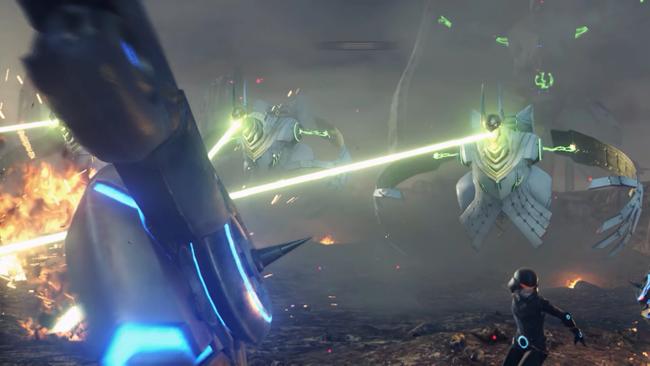
The developers flex their technological prowess as significant combat encounters seamlessly transition from cutscene to gameplay with no fade transitions at all. To mask the loading transition, the cutscene deliberately zooms in on foes right before the battle starts, switches to the gameplay instance, and zooms out right as the encounter begins.
Early combat mechanics in Xenoblade 3 are identical to other past Xenoblade titles. Everything happens in real-time, and each of your characters will automatically attack with their weapons once in range. They can execute abilities called Arts and these early initial ones are recharged after a cooldown period. Some Arts may inflict a status ailment or deal bonus damage, depending if a character is in front, behind, or at the enemy’s side. Xenoblade players will be at ease here, since Xenoblade 3 equips players with the Break, Topple, Daze combo right away to disable enemies from acting momentarily.
As a character continuously uses Arts, they will eventually be able to fire off a unique Talent Art. In Noah’s default class, his Talent Art will deal a huge chunk of bonus damage to a dazed target. Talent Arts from different classes are all unique; Eunie’s class under her Healer role can summon a circular field that gradually regenerates HP to anyone in it.
Although the battle screen can feel cluttered at times, Xenoblade 3 does an excellent job at surfacing vital combat data to players. It has distinct icons depicting if the character the player is controlling is in range to execute their auto attacks and what position they are in relation to the enemy, which is particularly useful against smaller foes. There are color-coded aggro lines that convey which character has the attention of each enemy. A blue aggro line immediately tells players that a Tank is catching their attention and Tanks are well-suited to receive hits; meanwhile, a red aggro line serves as a warning that an enemy is targeting either an Attacker or Healer and they are not built to take that much damage, so Tanks and other roles must work with one another to control the targeting priority of the opposing force.
Players can swap to any other character in the middle of combat, so if they want to take over a specific role or job manually for a fight, they are free to do so at any time. Several tactical orders can have the AI party members all prioritize the same target and move them closer to the character that the player is controlling.
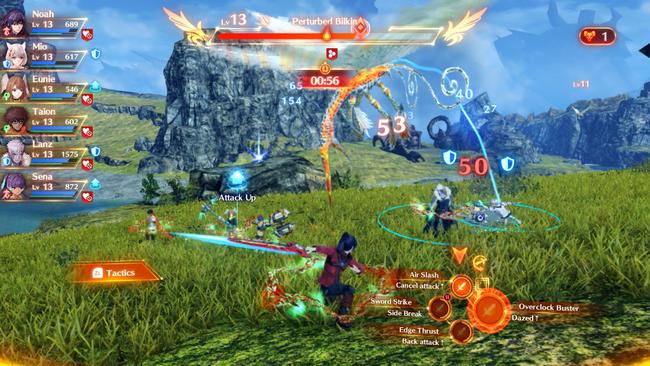
An aspect of battle that initially irritated me is that its flow is constantly interrupted by brief, but common, instances of slowdown. It is not because of a technical performance issue - rather, it is one baked into its game design. Every time a battle “event” occurs, such as an aggro line getting broken as a foe switches its attention to another ally or when an enemy enters a Break, Topple, or Daze state, the game will slow down briefly for half a second before running back to full speed. It seems to be a safety net for players to mentally register what is happening as the state of battle alters, though I personally wish there was a toggle to turn the slowdown effect off. I got used to it, though I occasionally mistime Arts canceling because of an unexpected slowdown.
There is an auto-battle option that can be toggled on that is handy for easier fights. The AI generally does a good job getting into a spot that will activate any positional Arts effects. Auto-battles generally get the job done in a sub-optimal manner, though it is effective if the player just wants to relax for a bit and focus their attention solely on exploring.
Every single tutorial you receive in Xenoblade 3 is archived under the Tips section in the options menu. Players can rest easy knowing they can always come back and review any tutorials they missed or misunderstood. Monolith Soft has included a separate Training Drills feature that even lets people redo any combat tutorial they’ve come across to ensure they understand a specific mechanic.
After the initial battle tutorial introducing the very tip of Xenoblade 3’s iceberg of combat systems, the game takes a step back once more to give a deeper look of how its warped world operates. Once again, much of this was revealed in the recent Nintendo Direct for the game.
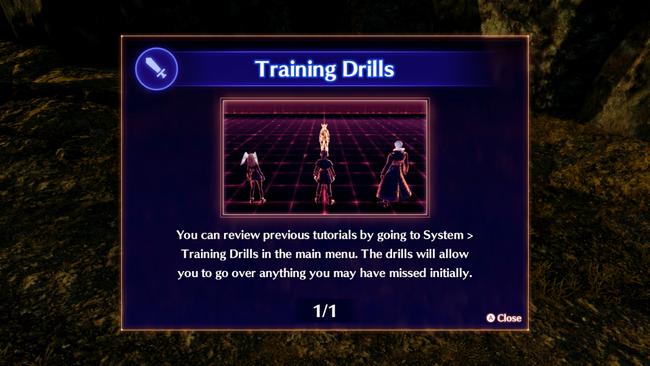
Keves and Agnus both serve a masked Queen. Both look eerily similar to characters from past games, but I imagine only way later in the game will it confirm or deny if this is actually the case. As people die on both sides, these Queens seemingly produce clones to replenish their forces. Every person serving these two nations is a clone and they can only live up to ten years, though not many live long enough to carry out their entire lifespan. From their “birth”, they are trained to fight and become soldiers.
Characters express their age in terms, so someone who is six-years-old would be considered in their “sixth term”, instead. People “fortunate” enough to see the end of their tenth term will undergo a Homecoming ceremony, in which their entire being becomes vaporized by the nation’s Queen and their life essence is believed to return to her. Homecomings are perceived as something that is normal to look forward to and a practice that is revered - a ceremony to celebrate ending someone’s life after ten years of continuous fighting.
There is an extended cinematic that plays early into Xenoblade 3 that explores this thoroughly, as players see a younger version of our heroes train against others in some sort of military facility. So on top of its initial heavy themes surrounding the endless fighting between Keves and Agnus sucking up each other’s life energy again and again, Xenoblade 3 already dives into the central concept of child soldiers right away.
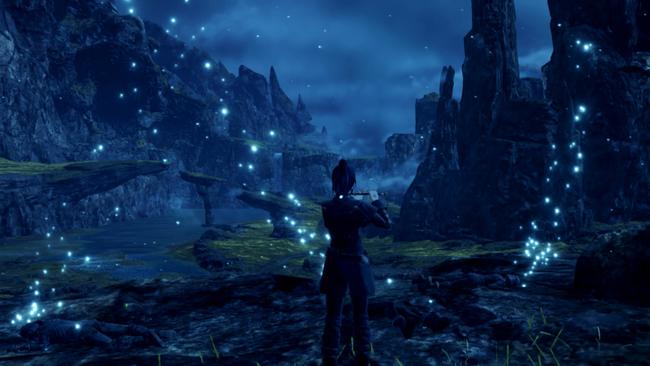
Exploring the map and running around in Xenoblade 3 is a similar affair to past titles with some new features introduced early on. People can now toggle on a quest navigation line that will mark a line on the ground to follow if they are unsure of how to reach their destination. This line can be a bit deceiving, since it does not account for the levels of enemies along the way; players will still have to be situationally aware that the line is not cutting through a level 80+ monster that is all but ready to one-shot and wipe their entire party if they get too close.
There is a handy shortcut menu that people can access by holding the ZL button while they are running around. This allows for immediate access to a particular menu without having to pop up the central menu screen first, so ZL+B can pop up the Quests list right away and ZR+X toggles quest navigation on. Even though only four can be accessed at a time, players can manually assign what each face button corresponds to from a number of menu options, so there’s a certain degree of shortcut customization in binding certain functions for immediate access.
There are other gameplay quirks that returning Xenoblade players may want to note with Xenoblade 3. There is fall damage and it is quite harsh; a long fall will kill your playable character and warp you back to the nearest checkpoint. Battles can be fought in water now. Gone are the days of having to maneuver around bodies of water that may jeopardize your approach to underwater enemies. Surprisingly, there have not been any instances in battle that contain a quick-time event or mini-game for people to perfectly time a button press for a mechanic either. If a NPC has any new dialogue for players, a star icon will be displayed by them.
Xenoblade 3 is very heavy-handed with its tutorialization in its opening hours, making players follow along with its step-by-step guides in menu navigation, outfitting characters with accessories, more battle tutorials, and so on. It is clear, concise, and makes sure that people follow its instructions or they cannot proceed.
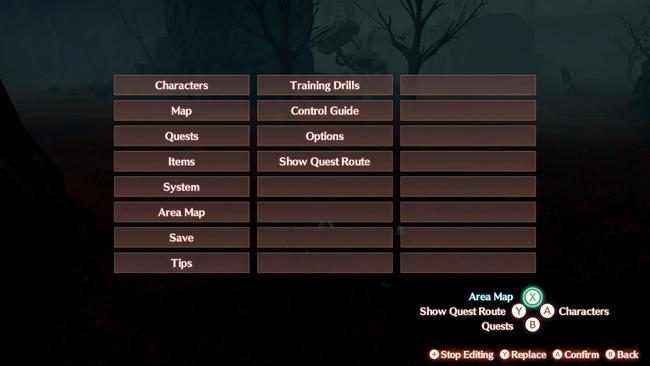
I think one of the early weaknesses of Xenoblade 3, albeit an understandable one, is that no environment early on has quite caught my attention in the same way that some of the early zones in Xenoblade 1 and 2 have had. A lot of what I traversed through early on were dull, dreary places that were still suffering the aftereffects of a brutal battle that previously transpired.
Xenoblade 3 does not carry the same initial sense of adventure that Shulk and Rex did when their games began; it is all about establishing the current twisted status quo of the world. Inhabitants of Aionios under Keves and Agnus carry a very different set of values and priorities to what we would consider the norm, so much of Xenoblade 3’s early goings is that it is intrinsically a depressing world, so its environments reflect that.
Even Noah’s occupation as an off-seer reminds players of the dour circumstances. Every so often, players will come across corpses, referred to as husks, and Noah enacts his off-seer duties by playing a tune on his flute to carry the voices of the deceased on peacefully.
One of the early aspects of Xenoblade 3 that I’ve come to appreciate already is its down-to-earth approach to tone compared to Xenoblade 2. Characters are handled with a more level-headed and mature approach, which is different from Xenoblade 2 in how that entry borrowed caricatures inspired by shonen stories and works in Japan. I found that endearing in its own way, but Xenoblade 3 is very much not a game that is full of over-the-top personalities and exaggerated interactions.
This tonality is more-or-less maintained throughout, even in a very early scene that has Noah, Eunie, and Lanz cleanse themselves at Colony 9, their home base camp settlement. It is a mixed community bath, and they are all fully nude in the same pool together. At certain points in this scene, Eunie and Lanz get up to start bickering with one another about Lanz’s recklessness that led to him getting a minor injury. There are no signs of embarrassment or awkwardness toward each other as they speak to each other all fully naked; it’s handled completely naturally and establishes certain intrinsic worldviews without explicitly spelling it out to players.
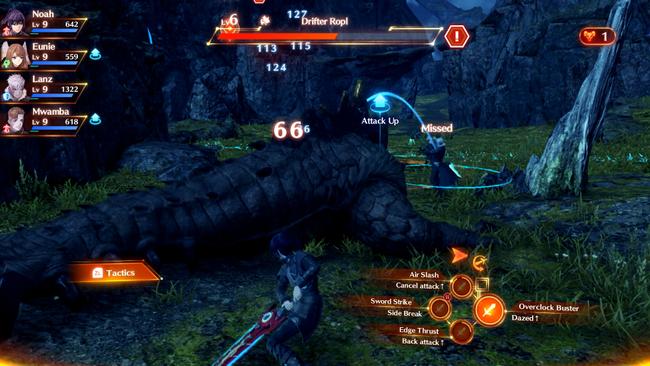
Much of Chapter 1 in Xenoblade 3 is getting acquainted with a small portion of its battle system and tackling early tutorial side quests for the inhabitants of Colony 9. The region that surrounds the colony gives a small taste of the usual early-game Xenoblade formula with many low level monsters and the occasional unique enemies that give a boatload of experience and goodies. In Monolith Soft fashion, some portions of the map are filled with significantly higher leveled enemies that need to be explored at a later time. Side quests and other activities grant bonus experience, instead of regular experience that’s gained from fighting. These can be used at rest spots, such as campfires, to manually level up your characters in a similar manner to Xenoblade 2.
At a certain point late into Chapter 1, Keves and Agnus forces both close in on a mysterious energy source carried by an unknown third party. As established throughout Xenoblade 3’s trailers, the core six characters are initially against each other because half of them are from Keves and the other half is with Agnus. Noah, Eunie, and Lanz face off against Agnus’s Mio, Taion, and Sena and neither side is able to get the upper-hand against the other.
Guernica Vandham, an older man from the unknown third party, attempts to stop both sides from killing each other. Before he’s able to get through to them about the “real enemy”, another strange entity steps into the fray. Everyone is forced to work together due to the sheer power of the gigantic, enigmatic foe. Out of desperation from things going south quickly, Guernica activates a device that unleashes the mysterious energy source that was initially detected.
Each of the main characters get a glimpse of someone else’s memories, experiences, and values from the opposing side; Noah and Mio reach an understanding and combine to become an Ouroboros mechanoid to go toe-to-toe against the threat, who refers to themselves as Moebius. This initial encounter shapes the real story players undertake in Xenoblade 3. As Moebius retreats, they fire a signal into the sky that turns the entire world against the main six that have now become “Ouroboros”. Their lives up to this point have drastically changed because becoming Ouroboros has freed them from their Flame Clocks, so they are no longer incentivized to try and reap life energy from each other in order to survive.
As they gradually figure out that no one from their respective Colonies no longer recognizes them, and that they are now treated as hostiles from all sides, the six characters are forced to make amends with one another to work together for their journey ahead. Guernica told them to go to a specific far-off place that may be able to help them with their situation. It’s important to note that Guernica is the very first ‘old’ person that the characters have ever met in their lives; they’ve never seen someone over the “age” of 10 and Guernica was reaching 60, so everything they have ever known is thrown into question.
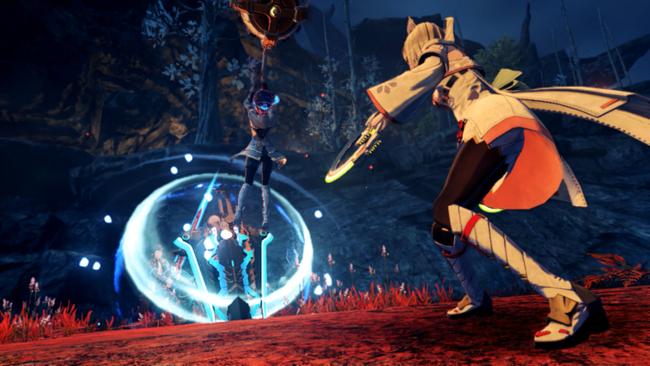
With players now having access to a second trio in Mio, Taion, and Sena, there is an important distinction in their playstyle. Unlike the trio from Keves, their Arts recharge like the ones in Xenoblade 2; auto-attack hits recharge them, instead of a timed cooldown. This is vital in understanding some of the last features I’m allowed to discuss for Xenoblade 3’s battle system for now.
Shortly after the party comes together, players unlock the feature to change classes for Noah, Mio, Eunie, Taion, Lanz, and Sena. They have been accumulating class experience for their default Swordfighter, Zephyr, Medic Gunner, Tactician, Heavy Guard, and Ogre classes respectively. Classes have an initial rank cap of 10; once they reach that, they can no longer earn experience points for that class until something is able to uncap it much later.
When a character takes on a class, there are five skills immediately available for it though only three of them can be equipped for combat, since the fourth slot is for the class’s Talent Art. As the class ranks up, all of its skills become better and better.
When characters switch over to another class, they can choose Master Arts to further expand their options in combat. They are a secondary set of Arts that is inherited from ranking up other classes. The caveat is that Master Arts can only be taken from classes that belong to the other nation.
For instance, Noah’s default Swordfighter class can only equip Master Arts learned from Mio’s default Zephyr class, Taion’s default Tactician class, and Sena’s default Ogre class because those three are from Agnus. Noah cannot equip Master Arts from the default Medic Gunner and Heavy Guard classes that Eunie and Lanz possess because these classes are from Keves.
A simpler way to think about this is that classes that recharge Arts on cooldown cannot equip Master Arts that recharge on a cooldown as well. If a class’s Arts replenish through a cooldown timer, then its accompanying Master Arts must have Arts that are replenished through auto-attacks instead. If Noah were to switch to the Zephyr class, then he may equip Master Arts from Swordfighter, Medic Gunner, and Heavy Guard because Zephyr’s Arts work on an auto-attack cooldown, while those three classes employ Arts that work around a cooldown timer.
Now when a Master Art is equipped, that character now has access to a Fusion Art which combines the effects of the paired Class Art and Master Art when they are both recharged and fired off simultaneously. The Fusion Art will execute the normal animation of the Class Art, but it will contain any applicable effects that both the Class Art and Master Art have. If the Class Art inflicts Break from a side attack and its paired Master Art inflicts Bleed, then the Fusion Art will inflict Break if it hits the side of the enemy and Bleed at the same time.
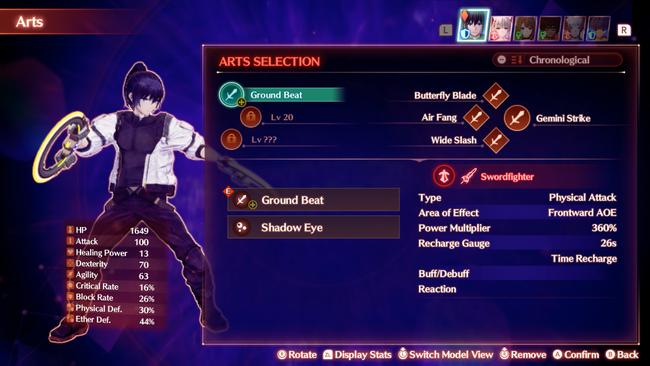
Arts canceling plays an important factor in manipulating the flow of battles and cooldowns. Characters can cancel the animations of auto-attacks into single Arts or Fusion Arts; properly arts canceling regenerates Arts that recharge through auto-attacks a tiny bit faster. Single Arts cannot cancel into other single Arts early on, but can be canceled into an available Fusion Art.
Additionally, Hero characters gradually join the core six in their journey and they bring along their own unique class that characters can swap to and learn their skills to further unlock more combat options. Heroes themselves act almost like a 7th guest party member, with their equipment predetermined for them. When a Hero joins the party, one of the six will automatically “inherit” their class and have it immediately available to swap to. In order to have the Hero class unlocked for everyone else, either they must fight alongside the party for a while or their inheritor equips the Hero’s class and the other characters will gradually unlock it from them instead.
Characters that swap classes also wear the clothing of that class, so Xenoblade 3 might be the definitive JRPG when it comes to how many times a group of friends swap into each other’s clothes constantly. The game does allow players to change the appearance of each character’s outfits to another class, regardless of which class they’re on, as shared by the Nintendo Direct for Xenoblade 3 a few weeks back.
It is worth noting that character models get more and more dirty over time until a plot event cleans them up or players choose for them to clean up at rest spots. Early on, characters just get progressively more filthy as their bodies are practically covered in dirt during cutscenes.
Lastly, the dual audio option is included with Xenoblade 3 from the get-go. There is no separate download for the Japanese voices like with Xenoblade 2.

There is still a mountain of stuff to learn and do in Xenoblade 3 beyond this early look into Monolith Soft’s upcoming massive RPG. I have had a fantastic time with the game so far and I’m eager to dig deeper into it. There is so much potential in Xenoblade 3 and these early hours have only sparked my interest more and more. I hope this tiny spec of information in this preview piece helped clear up some confusion now that I’ve had some hands-on time with it.
Xenoblade Chronicles 3 launches on July 29 for the Nintendo Switch, so it’s only just a few weeks away.